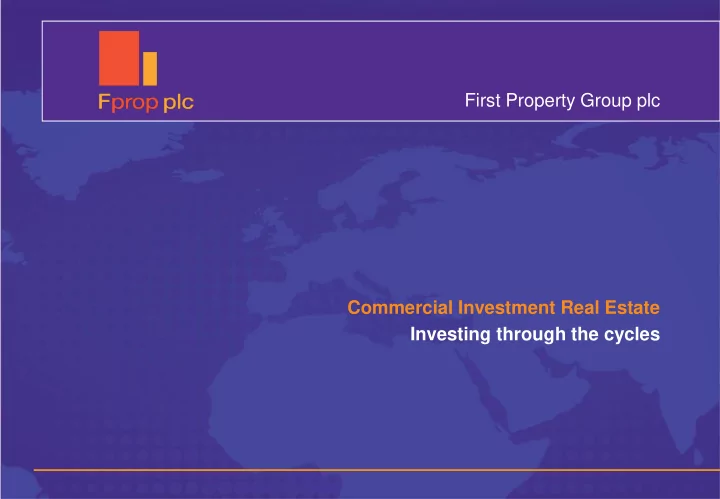

First Property Group plc Commercial Investment Real Estate Investing through the cycles
Table of Contents Liquidity: Property vs. Equities vs. Bonds 3 Costs of Buying Commercial Property 4 The Need for Yield 5 Income Return 6 Prime London vs. Prime Warsaw Yields 7 Obsolescence 8 Green Issues/ Sustainability 9 Inflation Hedge Debunked 10 Conclusions 11 First Property UK Track record 12 2 2
Investing Through the Cycles Liquidity: Investment Property vs. Stock Market vs. Gilt market 1200% UK Gilt Market (7+ years) 1000% Value Traded vs Avg Annual Amount in Issue 800% 2010: £2,900 billion [517% of £564bn market value] UK Stock Market Value 600% Traded vs Market Cap 400% 2010: £2,500 billion UK Property Turnover vs [146% of £1,720bn market value] Investment Market Size 200% 2010: £28 billion [3.5% of £813bn market value] 0% 2006 2007 2008 2009 2010 3
Investing Through the Cycles Cost of Buying Property The cost of trading property is relatively high: 4% stamp duty 1% agent’s fees 0.8% legal and valuation fees 5.8% The cost of trading publicly quoted stocks is relatively low: 0.5% stamp duty 0.25% broker’s fees 0.75% Just to break even on an investment, a property’s value must increase by at least 6 %: But relying on capital gain for such an inherently illiquid asset may be risky. Or over a 5 year hold period for UK prime Property, more than one year’s income is lost in acquisition costs. These frictional costs have to be addressed. 4
Investing Through the Cycles The Need for Yield 10.00% 9.00% Yield gap gone for secondary properties 8.00% Average Secondary 7.00% Yields 6.00% Average Yield Prime 5.00% Yields 4.00% Bank Base 3.00% Rate Yield gap reversed for prime properties 2.00% 1.00% 0.00% Mar 1999 Mar 2000 Mar 2001 Mar 2002 Mar 2003 Mar 2004 Mar 2005 Mar 2006 Mar 2007 Mar 2008 Mar 2009 Mar 2010 Mar 2011 Source: CBRE, Bank of England Yields are average of office and retail yields 5
Investing Through the Cycles Capital Value Volatility 8.0% 7.5% 7.0% 11% increase 30% reduction in value in value 6.5% Poland (Warsaw) Prime Yields Yield 6.0% 20% increase 5.5% UK Prime Yields in value 5.0% 47% reduction in value 4.5% 4.0% 2005 2006 2007 2008 2009 2010 2011 Source: CBRE UK Prime Yields are average of London office and UK prime retail yields. Poland (Warsaw) Prime Yields are average of Warsaw office and retail shopping centre yields 6
Investing Through the Cycles Income Return as % of Total Return 25 20 15 10 5 Capital Growth 0 % Income Return -5 -10 Total Return -15 -20 -25 -30 2001 2002 2003 2004 2005 2006 2007 2008 2009 2010 20 10 5 Years 3 Years Years Years Source: Investment Property Databank (IPD) All Property UK Universe Over the longer term income is the main driver of investment returns 7
Investing Through the Cycles Obsolescence Simple buildings are best: Retail warehousing; Functional offices; Warehouses. Need to keep costs/ rents low, especially in this environment. Simple/ cheap construction allows this. Old buildings in prime locations can be better than Class A buildings in prime locations. Often better to buy assets which have already aged, than brand new. The above dovetails with high yield approach. 8
Investing Through the Cycles Green Issues/ Sustainability A lot of attention to this subject recently. It is in fact a small part of a property’s costs. Key is overall cost to tenant: rent and services charges, not service charges alone. Service charges are a small percentage of overall tenant costs. The economic effects are of crucial importance, particularly at the moment. Regulatory changes may influence this but not likely. 9
Investing Through the Cycles The Inflation Myth Commercial property is not an obvious hedge against inflation. Supply side led inflation is BAD for property. Rampant demand led inflation is ultimately BAD for property. Mild demand led inflation is good for property. 10
Investing Through the Cycles Conclusions Property is illiquid and expensive to transact. The only sure way to overcome this illiquidity and expense is to target high yields. There must always be a gap between the cost of funds and the yield earned on property. Prime property is low yielding and can be very volatile. There is a bubble in UK prime property. Sustainable high yields are likely to be less volatile. High yields cushion capital value movements. State of the art properties can only depreciate. It can be better to buy buildings which have already gone through this process or are simple in nature. Green issues are of subsidiary importance when assessing returns. Property is not, per se, an inflation hedge. 11
Investing Through the Cycles First Property UK Track Record 8.5% 8.0% 2 2 2 4 3 3 Sale (with 2 7.5% Average UK Yields (CBRE) the number 2 sold) 7.0% 2 2 3 Purchase 6.5% 3 (with the number 2 purchased) 2 2 6.0% 3 5.5% 2 2 5.0% 3 5 4.5% Mar 2000 Mar 2001 Mar 2002 Mar 2003 Mar 2004 Mar 2005 Mar 2006 Mar 2007 Mar 2008 Mar 2009 Mar 2010 Mar 2011 N.B: Where no number is provided only one property was transacted Average UK yields are the average of prime and secondary office and retail yields (source = CBRE). 12
Recommend
More recommend